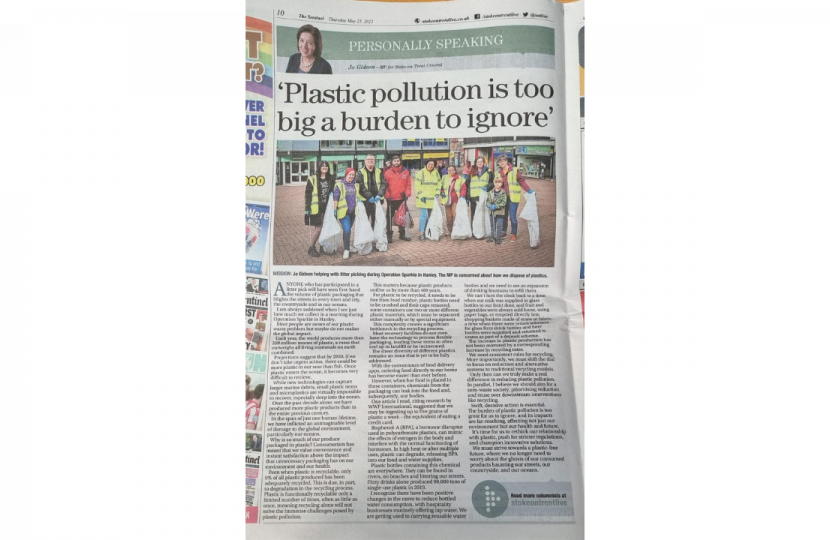
Anyone who has participated in a litter pick will have seen first-hand the volume of plastic packaging that blight the streets in every town and city, the countryside and in our oceans. I am always saddened when I see just how much we collect in a morning during Operation Sparkle in Hanley. Most people are aware of our plastic waste problem, but maybe do not realise the global impact.
Each year, the world produces over 350 million tonnes of plastic, a mass that outweighs all living mammals on earth combined. Projections suggest that by 2050, if we don’t take urgent action, there could be more plastic in our seas than fish. Once plastic enters the ocean, it becomes very difficult to retrieve. While new technologies can capture larger marine debris, small plastic items and microplastics are virtually impossible to recover, especially when they sink deep into the ocean.
Over the past decade alone, we have produced more plastic products than in the entire previous century. In the span of just one human lifetime, we have inflicted an unimaginable level of damage to the global environment, particularly our oceans.
Why is so much of our produce packaged in plastic? Consumerism has meant that we value convenience and instant satisfaction above the impact that unnecessary packaging has on our environment and our health.
Even when plastic is recyclable, only 9% of all plastic produced has been adequately recycled. This is due, in part, to degradation in the recycling process. Plastic is functionally recyclable only a limited number of times, often as little as once, meaning recycling alone will not solve the immense challenges posed by plastic pollution. This matters because plastic products outlive us by over 400 years.
For plastic to be recycled, it needs to be free from food residue; plastic bottles need to be crushed and their caps removed; some containers use two or more different plastic materials, which must be separated either manually or by special equipment. This complexity creates a significant bottleneck in the recycling process. Most recovery facilities do not even have the technology to process flexible packaging, leading these items to often end up in landfill or be incinerated. The sheer diversity of different plastics remains an issue that is yet to be fully addressed.
With the convenience of food delivery apps, ordering food directly to our home has become easier than ever before. However, when hot food is placed in these containers, chemicals from the packaging can leak into the food and, subsequently, our bodies. One article I read, citing research by WWF International, suggested that we may be ingesting up to five grams of plastic a week – the equivalent of eating a credit card.
Bisphenol-A (BPA), a hormone disruptor used in polycarbonate plastics, can mimic the effects of estrogen in the body and interfere with the normal functioning of hormones. In high heat or after multiple uses, plastic can degrade, releasing BPA into our food and water supplies.
Plastic bottles containing this chemical are everywhere. They can be found in rivers, on beaches, and littering our streets. Fizzy drinks alone produced 90,000 tons of single-use plastic in 2019.
I recognise that there have been positive changes in the move to reduce bottled water consumption, with hospitality businesses routinely offering tap water to customers. We are getting used to carrying reusable water bottles, and we need to see an expansion of drinking fountains to refill them.
We can’t turn the clock back to a time when our milk was supplied in glass bottles to our front door, and fruit and vegetables were always sold loose, using paper bags, or emptied directly into shopping baskets made of straw or fabric; a time when there were return schemes for glass fizzy drink bottles and beer bottles were supplied and returned in crates as part of a deposit scheme.
The increase in plastic production has not been mirrored by a corresponding increase in recycling rates. We need consistent rules for recycling. More importantly, we must shift the dial to focus on reduction and alternative systems to traditional recycling models. Only then can we truly make a real difference in reducing plastic pollution. In parallel, I believe we should aim for a zero-waste society, prioritising reduction and reuse over downstream interventions like recycling.
Swift, decisive action is essential. The burden of plastic pollution is too great for us to ignore, and its impacts are far-reaching, affecting not just our environment but our health and our future. It’s time for us to rethink our relationship with plastic, push for stricter regulations, and champion innovative solutions. We must strive towards a plastic-free future, where we no longer need to worry about the ghosts of our consumed products haunting our streets, our countryside, and our oceans.
